That Oh So Special Time
I recently came across a Jamaica travel video done by voyagetv.com called Hands-On History. It features Bellefield Great House, Montego Bay. Not one to pass up anything to do with great houses, one of my favourite archetypes, I settled down to watch the little 7-minute flick.
To the beat of African kette drums a disembodied voice says:
The Family came to Jamaica in 1655…David Kerr was posted as a physician…the Great House is thought to have been a crack cholera hospital…married Sarah Jarrett, Col Jarrett only had daughters, hence the hyphenated ‘Kerr-Jarrett’. (Whichever) Kerr-Jarrett was a forefather of nation building in Jamaica…a philanthropists and “strong supporter of Jamaican culture and history.”
Hold that thought.....
 We are shown how the mill worked and how the workers worked it, the mill’s points of entry and egress, and where the cane juice would be stored in barrels before being sent to the boiling house to be reduced to molasses, then sugar:
We are shown how the mill worked and how the workers worked it, the mill’s points of entry and egress, and where the cane juice would be stored in barrels before being sent to the boiling house to be reduced to molasses, then sugar:
Someone drank the sugared Kool-Aid.

Chamber music interlude now brings us to the formal dining room, ‘slave’ lady trailing behind. Over the lavishly laid out dining table, Ms Rousseau tells us of Lady Nugent referring to “festivities and feasts” she would attend in such a setting where a “plush array of food including crab patties and Sangaree” would be served. Seems like more scholarly research went into the unearthing of an 18th century cookery book with all these “plush” recipes that are now recreated at Bellefield Great House.
On to the pantry room annexed to the outdoor kitchen; ‘slave’ lady silently in tow. We see her one active role: that of holding on to the pestle and touching the ginger jar. She is obviously speaking to someone, but no voice is heard. Her voice like that of her ancestors', excised. The taster is jokingly surmised by Ms Rousseau to have been a rather large lady as her duties comprised no more than sitting on a chair and tasting food. Boys would bring the food from the kitchen, whistling so that the Kerr-Jarretts and their guests would be assured that their food was not being eaten on its way in.
The ‘slave’ lady stands aside as the ladies walk out to the verandah: Ms Rousseau’s favourite part of the house (no doubt for the vantage point it affords her of the vast, picturesque estate). One gets a glimpse of the impeccable gleaming polished floors, white shutters and fretwork, wall sconces and Chippendale and Queen Anne chairs as the ‘slave’-in-waiting stands uncomfortably in the room that is as much hers as anyone else’s. Houses need to be maintained: floors polished, furniture and windows dusted, walls repainted, linens washed, ironed, straightened….
Learning from the Portuguese and the Spanish by way of their colonies in the Atlantic (Azores, Madeira, Canary Islands, Saõ Tomé and Princípe, etc), the British imported and forced African labour to grow sugar in their West Indian colonies. Africans were not originally used for the labour in West Indian colonies. Indigenous Taino, lost to European diseases (eg, smallpox, measels), the indentured poor of England and Ireland, and condemned criminals were also used, but these sources were not as strong, adaptable, or as cheap as the African slave. One cannot dissociate sugar from slavery.
By the 1730s Jamaica was the largest single producer of sugar in the British Caribbean. By 1800 nine out of every ten people in Jamaica were enslaved. In 1805, Jamaica exported more tonnes of sugar than any other country. Slaves were needed to maintain this sweet life both on the plantations and abroad. They toiled excessively, working from dawn til dusk, and were punished severely for the slightest infraction. They lived in crude, flung-up dwellings situated nearby the sugar works. Man, woman and child planted, weeded and harvested under the watchful eye of the overseer (Busha) and his whip. Mature cane was cut, loaded and dragged to the mill where it was pressed through huge rollers to extract the juice, which would then be taken to the boiling house. This was dangerous business. Those unfortunate enough to get a hand caught in the rollers would be caught up and pressed to death. Axes were kept nearby to chop the hands/arms off anyone who got a hand caught in the mill-press. Boiling houses were insufferably hot and slaves were prone to being burnt severely by boiled sugar: “If a boyler get any part into the scalding sugar it sticks like Glew, or Birdlime, and ‘tis hard to save either Limb or Life.” [1]
Lashed and cudgelled, slaves would have salt rubbed in their wounds or molasses poured on them to attract biting flies and ants. Firebrands were applied to their bodies; ears would be cut off, roasted then forced fed to them. From Thom Thistlewood’s diary, author Douglas Hall narrates:
The untenable situation of Plantation slavery led to many revolts, which produced more brutal, tyrannical masters. Yet too often are we led to believe that these well-dressed, smartly depicted colonisers, landed proprietors, and their families were paragons of virtue. An unbiased look at history reveals that more often than not plantation/colonial life seemed to socialise one to being base minded, brutal, murderous, and sexually immoral:
Abolitionist Mary Prince often wondered
James Stewart’s account of the goings on Jamaica:
Ned Ward, an English writer who travelled to Jamaica in 1697 had this to say of the colony:
Ward describes a colony peopled with the what lef of British society. The not-first-born sons who didn’t stand to inherit and were ill suited for the clergy or scholarly pursuit, women of dubious character, failed professionals, criminals and vagabonds.
We are also told by Ms Rousseau of 1805 Jamaica (and by extension the Colonial era) being a “special place” in time. Nothing could be further from the truth. 1805 was a turbulent time. War was brewing between North America and Britain. France, Spain, Portugal and Britain were fighting the Penninsular Wars; a segue from the French Revolutionary wars. Spain was courting rebellion from New Spain (Mexico). The winds of abolition began blowing in 1787 with the formation of the Society for Effecting the Abolition of the Slave Trade. Slavery was quickly being viewed as a national disgrace. America too felt these winds of change. In 1787 Rhode Island prohibited its citizens from engaging in the trade. In 1791 the first of several bills was introduced in British Parliament for the end of the slave trade. In 1804 the region’s most successful revolt occurred on the island of Saint-Domingue and gave birth to the first black republic, Haiti. Lady Nugent (then just Mrs Nugent), who arrived in Jamaica in 1801 during the Penninsular Wars was terrified that revolting Haitian slaves’ sentiments would spread to her happy blackies in Jamaica.
 In 1805 Jamaica was under Martial Law and in imminent danger of being attacked by the French. The Slave Trade Act was finally passed in March 1807 and enforced on 1 January 1808. Lady Nugent didn’t arrive in Jamaica to sip sangaree at lavish parties. Her presence in Jamaica is a result of her husband, GENERAL George Nugent being sent to the colony as Lieutenant-Governor and part of Britian’s military regiment charged with defence of the colony and suppression of slave rebellions.
In 1805 Jamaica was under Martial Law and in imminent danger of being attacked by the French. The Slave Trade Act was finally passed in March 1807 and enforced on 1 January 1808. Lady Nugent didn’t arrive in Jamaica to sip sangaree at lavish parties. Her presence in Jamaica is a result of her husband, GENERAL George Nugent being sent to the colony as Lieutenant-Governor and part of Britian’s military regiment charged with defence of the colony and suppression of slave rebellions.
Europe has a long tradition of pastoral paintings, not the least of which is the Picturesque genre. Mid 18th century saw the advent of the Age of Romanticism: a reaction to the preceded Age of Enlightenment/Reason. Romanticism rejected the notions of the Enlightenment and its rationalism in favour of a focus on the individual, the subjective, the instinctual, the trancendental, the emotional and the visual. There was a deeper appreciation of nature and Man's relation to his physical world. Nature is now portrayed to dominate insignificant, dimunitive Man.
Sensibility, an emotive response to something that gives one an understanding of it, replaced the logic and rationalism of the Enlightenment. Romanticism in art and its preoccupation with nature and counter-rationalism concerned itself with the triumvirate: sublime, picturesque and beauty.
Much artifice was used in picturesque paintings to bring them to life. The artist began with the natural setting, which was true, then implemented common themes of the genre: the irregular, anti-classical (thus anti-Enlightenment); ruins (by way of Follies, ie, artificial ruins) & ruined people.
Seemingly wild nature was juxtaposed with tame swaths of land; large, skewed trees were drawn aside like curtains to reveal happy serfs, farmers, peasants going about their happy, contented lives, engaging in faked interrelations and tending to their pastoral flocks and crops. Sweeping vistas with depths of field approaching infinity suggest a never-ending day. These scenes are contrived. A depiction of what the observer imagines must take place in such a beautiful and awesome setting. A mash-up of disparate things used to portray an ideal (idyll??) picture of a utopia that DID NOT EXIST.
I agree with the man! He’s saying one needed very little artifice to improve upon Jamaica’s brand of Nature. I think Jamaica exceedingly, hauntingly, mystically, timelessly beautiful. But I’m not blind to the evil and the profane and the injustice that occurs there at the hand of its inhabitants.
George Robertson's Spring Head of Roaring River, 1775 (Roaring River flowed through the property of William Beckford Esqr) depicts a bucolic, pastoral scene. Note the human subjects foregrounded. The woman is depicted postured with regal bearing. She is adorned: wearing something around her neck (that almost looks like a string of pearls). Her clothing, though plain, is neat and shows her figure off to advantage. The male, supplicated before her, shows her his provisions in a 'rustic act of kindness' that the art historians tell us was a favoured theme amongst the English painters of the picturesque genre. He is of a darker complexion and is much more humbly dressed, just like the cattle herder in the background. The unspoilt, arcadian, pastoral beauty of nature that surrounds them mimics many landscape scenes popular in Britain at the time,
excepting the race and legal status of the people.
The above section regarding art and its interpretation merely skims the surface. A more thorough analysis was forfeited for expediency's sake. But one can see how such scenes, create(d) cognitive dissonance in many of their observers: There’s nothing brutal and inhumane going on here?! What are these abolitionists playing at? Why get rid of this life? What’s wrong with it? They seem happy to me?!?
This dissonance was/is so powerful; so potent, it spanned the geographic distance between Jamaica and Britain, and spans the temporal distance between slavery days and the 21st century, so that 200 years later we get:
Where, pray tell, are the 7-minute promotional soundbites and the Facebook pages that proudly display the ancestral portraits, soup toureens, mercury phials, penis syringes, bidets and other tchotchkes of the rag-tag descendants of Thom Thistlewood, 'Salt Beef Peg' and 'Buttock-de-Clink Jenny'?
-Torsdag
Bibliography
Barringer, Tim, Gillian Forrester, and Barbaro Martinez-Ruiz. Art and Emancipation in Jamaica: Isaac Mendes Belisario and His Worlds. New Haven and London: Yale Centre for British Art in association with Yale University Press, 2009. [3] [4] [7]
Hall, Douglas. In Miserable Slavery: Thomas Thistlewood in Jamaica 1750 - 1786. Barbados, Jamaica, Trinidad & Tobago: University of the West Indies Press, 1989. [2]
Parker, Matthew. The Sugar Barons: Family,Corruption, Empire and War in the West Indies. New York: Walker & Co, 2011. [1] [3] [6]
Wright, Philip. Lady Nugent's Journal: of Her Residence in Jamaica from 1801 to 1805. Barbados, Jamaica, Trinidad & Tobago: University of the West Indies Press, 2002. [5]
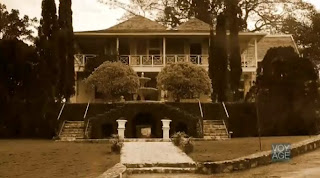 |
| Sepia hued Bellefield Great House coutesy of Voyage TV |
“It really is a step back in time, you know, in the heyday of our sugar production. So, you know, that’s kind of what we try to do here: take people back in time, you know, to 1805 before the abolition of slavery when Jamaica was a really special place….”
!!!
“Special place” FOR WHOM???
Ms Rousseau, owner of the disembodied voice, takes Voyage TV’s host and the viewer on a tour of the Great House and the sugar mill whilst bringing us up-to-date on the illustrious history of the Karr-Jarrett family; all to the sounds of a Rastafarian chanting and beating his kette drum.
The Family came to Jamaica in 1655…David Kerr was posted as a physician…the Great House is thought to have been a crack cholera hospital…married Sarah Jarrett, Col Jarrett only had daughters, hence the hyphenated ‘Kerr-Jarrett’. (Whichever) Kerr-Jarrett was a forefather of nation building in Jamaica…a philanthropists and “strong supporter of Jamaican culture and history.”
Ms Rousseau tells us that Jamaica was one of the largest sugar producing islands as she walks us over to the 100 year old cane press, the Chattanooga, where a black labourer (‘slave’?) feeds the press and guides the donkey. Journeying over to the sugar mill, built in 1794 of ships’ ballast, we are called to admire its beautiful thatched roof “supposedly the largest in the Caribbean”. Visibly impressed, Ms Voyage TV mentions “so this is where it really would have gone on, in here” “Yup!” Ms Rousseau responds, “It really would have gone on in here.”
Hold that thought.....
The camera pans out to show the viewer the conical structure, as a ‘slave’ lady walks past.
 We are shown how the mill worked and how the workers worked it, the mill’s points of entry and egress, and where the cane juice would be stored in barrels before being sent to the boiling house to be reduced to molasses, then sugar:
We are shown how the mill worked and how the workers worked it, the mill’s points of entry and egress, and where the cane juice would be stored in barrels before being sent to the boiling house to be reduced to molasses, then sugar:
“For eight-hour shifts at a time. So...labour intensive but well worth it. I think that..um..we all appreciate the joys of sugar.” Labour intensive but well worth it. ???
As Ms Voyage TV follows Ms Rousseau and the ‘slave’ into the great house, she turns to us the audience to inform us “Michelle Rousseau is an expert in local history, specifically about this plantation, so we’re so lucky to have her to show us around.”
Someone drank the sugared Kool-Aid.
We climb up the monumental staircase and into The Great House and Kette drum gives way to the dulcet sounds of refined chamber music. Inside, we get a brief rundown of the passive cooling/heating strategies employed building the house: the strategic siting of the house on a hill and turned to take advantage of high ground and cross ventilation, large fenestrations, thick walls (thermal mass) etc.
We’re now ushered into the main hall where both ladies sit under the portraits of Custos Kerr-Jarrett & his wife. Ms Rousseau proudly tells the story of Custos Kerr-Jarrett being knighted in the early 1930s and his insistence on being knighted in his home country:
“and so the Queen came to Jamaica and um he was knighted here…”

Ms Rousseau has overlooked the obvious fact that there was no Queen of England in the early 1930s! England’s monarch in the early 1930s was George V (1910 to 1936). Elizabeth II’s reign began in 1952. While she narrates the Queen knighting Custos Kerr-Jarrett, simultaneous film footage shows no Queen; just a very regal Sir Clifford Campbell, Jamaica’s first visibly black Governor-General (1962-1973) and Elizabeth ll’s representative, dubbing Custos Kerr-Jarrett Sir Knight. A quick Boolean search of Sir Francis Kerr-Jarrett yields documentation of his knighthood taking place on 31 August 1965.
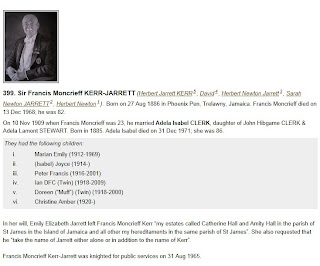 |
| Last line: Frances Moncrieff Kerr-Jarrett was knighted for public services on 31 Aug 1965 |
Chamber music interlude now brings us to the formal dining room, ‘slave’ lady trailing behind. Over the lavishly laid out dining table, Ms Rousseau tells us of Lady Nugent referring to “festivities and feasts” she would attend in such a setting where a “plush array of food including crab patties and Sangaree” would be served. Seems like more scholarly research went into the unearthing of an 18th century cookery book with all these “plush” recipes that are now recreated at Bellefield Great House.
On to the pantry room annexed to the outdoor kitchen; ‘slave’ lady silently in tow. We see her one active role: that of holding on to the pestle and touching the ginger jar. She is obviously speaking to someone, but no voice is heard. Her voice like that of her ancestors', excised. The taster is jokingly surmised by Ms Rousseau to have been a rather large lady as her duties comprised no more than sitting on a chair and tasting food. Boys would bring the food from the kitchen, whistling so that the Kerr-Jarretts and their guests would be assured that their food was not being eaten on its way in.
[and we wonder where this ingrained culture of treating helpers and 'yard boys' so badly comes from.]
The ‘slave’ lady stands aside as the ladies walk out to the verandah: Ms Rousseau’s favourite part of the house (no doubt for the vantage point it affords her of the vast, picturesque estate). One gets a glimpse of the impeccable gleaming polished floors, white shutters and fretwork, wall sconces and Chippendale and Queen Anne chairs as the ‘slave’-in-waiting stands uncomfortably in the room that is as much hers as anyone else’s. Houses need to be maintained: floors polished, furniture and windows dusted, walls repainted, linens washed, ironed, straightened….
On the verandah the ladies clink their white wine glasses and the scene fades to black to the trill of violin and harpsichord.
That seven minutes could be so packed with anachronistic, misrepresented drivel, that belie the blatant callousness and crude baseness of the era of slavery beggars belief! Even more shameful is that this grossly aberrant snippet serves a marketing device for tourism. What we are seeing is a biased version of history. A history being viewed through the eyes of the regional elite, or those who think themselves as such. Ms Rousseau tries hard to appease the white man, shamefully and ingratiatingly, she tries to identify with the white ancestors of yore as she meanders through sugar mill and Great House with absolutely NO CLUE what it is that she aspires to be connected to. In her ignorance she perpetuates the tyranny of the ancient inhabitants and the mores of their time by having staged ‘slaves’ and African music confined to the outdoors whilst refined chamber music plays indoors. The sanitized era of the 21 century cannot and does not excuse the ghosts of tyranny that once existed and moved between Great House walls and roamed their estates.
That seven minutes could be so packed with anachronistic, misrepresented drivel, that belie the blatant callousness and crude baseness of the era of slavery beggars belief! Even more shameful is that this grossly aberrant snippet serves a marketing device for tourism. What we are seeing is a biased version of history. A history being viewed through the eyes of the regional elite, or those who think themselves as such. Ms Rousseau tries hard to appease the white man, shamefully and ingratiatingly, she tries to identify with the white ancestors of yore as she meanders through sugar mill and Great House with absolutely NO CLUE what it is that she aspires to be connected to. In her ignorance she perpetuates the tyranny of the ancient inhabitants and the mores of their time by having staged ‘slaves’ and African music confined to the outdoors whilst refined chamber music plays indoors. The sanitized era of the 21 century cannot and does not excuse the ghosts of tyranny that once existed and moved between Great House walls and roamed their estates.
Let’s take Ms Rousseau at her word and flesh out exactly what “really would have gone on” in the sugar mill, the boiler room, the estate, the country and the era of Colonialism for that matter.
By the turn of the 18th century sugar became big business in Europe. In the early 1700s five pounds of sugar was consumed per capita in England, rising to 30 pounds per capita by the 1800s. Sugar was Britain’s largest imported commodity after cotton. Europe needed sugar to make new exotic drinks such as China tea, Arabian coffee and Central and South American xocolatl palatable. It was prescribed as medicine, moulded into elaborate displays, used as preservative, and as status symbol (including its effect of rotting teeth, which were proudly displayed as a signifier of wealth). Sugar is also the chief ingredient in rumbullion, via the fermentation and distillation of molasses. Rum was a staple of plantation life. What wasn’t drunk by the planters was exported for huge profit.
By the 1730s Jamaica was the largest single producer of sugar in the British Caribbean. By 1800 nine out of every ten people in Jamaica were enslaved. In 1805, Jamaica exported more tonnes of sugar than any other country. Slaves were needed to maintain this sweet life both on the plantations and abroad. They toiled excessively, working from dawn til dusk, and were punished severely for the slightest infraction. They lived in crude, flung-up dwellings situated nearby the sugar works. Man, woman and child planted, weeded and harvested under the watchful eye of the overseer (Busha) and his whip. Mature cane was cut, loaded and dragged to the mill where it was pressed through huge rollers to extract the juice, which would then be taken to the boiling house. This was dangerous business. Those unfortunate enough to get a hand caught in the rollers would be caught up and pressed to death. Axes were kept nearby to chop the hands/arms off anyone who got a hand caught in the mill-press. Boiling houses were insufferably hot and slaves were prone to being burnt severely by boiled sugar: “If a boyler get any part into the scalding sugar it sticks like Glew, or Birdlime, and ‘tis hard to save either Limb or Life.” [1]
Lashed and cudgelled, slaves would have salt rubbed in their wounds or molasses poured on them to attract biting flies and ants. Firebrands were applied to their bodies; ears would be cut off, roasted then forced fed to them. From Thom Thistlewood’s diary, author Douglas Hall narrates:
In July, Port Royal, who had run away, was taken and brought home. ‘Gave him a moderate whipping, pickled him well, made Hector shit in his mouth, immediately put in a gag whilst his mouth was full & made him wear it 4 or 5 hours.’
Next day, the 24th, a woman slave, Phillis, caught breaking canes, was similarly treated, but spared the gag.
Friday, 30th July 1756: Punch catched at Salt River and brought home. Flogged him and Quacoo well, and then washed and rubbed in salt pickle, lime juice & bird pepper; also whipped Hector for losing his hoe, made new Negro Joe piss in his eyes & mouth &c.
On the 4th, Derby was again caught, this time by the watchman as he attempted to take corn out of Col Barclay’s Long Pond cornpiece. He was severely chopped with a machete, his right ear, cheek and jaw almost cut off. On the 27th of the same month Egypt was whipped and given ‘Derby’s dose’ [that is Derby was made to shit in his mouth] for eating cane. On Thursday, 5th October, Hector and Joe and Mr Watt’s Pomona were similarly punished for the same misdemeanor. [2]
Innumerable accounts of such unbridled atrocities committed against slaves exist. Physical and mental. Planters discouraged slaves from suicide (a last ditch attempt by them to return to Africa via the afterlife) by chopping the heads off suicide slaves, telling the living that they would be resurrected in Africa without their heads. The same sugar that was reduced in the boiling house also played a role as reducer: coloniser and colonised were both reduced to something subhuman. Whilst the former produced sweet results, the latter produced bitter; with an aftertaste lasting for generations.
I’ll leave it up to the reader to decide if, per Ms Rousseau, the production of sugar through slavery, was “labour-intensive but well worth it” for so much as a hogshead of molasses or a puncheon of rum.
The untenable situation of Plantation slavery led to many revolts, which produced more brutal, tyrannical masters. Yet too often are we led to believe that these well-dressed, smartly depicted colonisers, landed proprietors, and their families were paragons of virtue. An unbiased look at history reveals that more often than not plantation/colonial life seemed to socialise one to being base minded, brutal, murderous, and sexually immoral:
British abolitionist Zachary Macaulay worked as a bookkeeper in Jamaica in the 1780s. Observing the violence, punishments and degrading conditions of slaves he remarked,
“The air of this island must have some peculiar quality in it, for no sooner than a person set foot in it than his former ways of thinking are entirely changed.” [4]
“how English people can go out into the West Indies and act in such a beastly manner. But when they go to the West Indies, they forget God and all feelings of shame, I think, since they can see and do such things. They tie up people like hogs – moor them up like cattle, and they lick them, so as hogs, or cattle, or horses never were flogged.” [4].
From the Journal of the aforementioned Lady Nugent:
“There is but little Society in Spanish Town or the neighbourhood”,”… “[General Nugent] described one member of the Assembly as “a gentlemanly Character, which is no trifling Merit in Jamaica”, and another as “decent in his Conduct but of low Origin in common with the great Majority of the Inhabitants.” It was difficult to find suitable men to fill the position of custos*, or chief magistrate of a parish – “in some of the Parishes, the white Population is so ill composed and so trifling in Numbers.”
But what troubled her more than the low origin of the planters was their ungodliness. This was a commonplace, remarked by all who had written about them [5]
*Custos Rotulorum. Part of the parochial administrative body. There was one for every parish. The Custos represented the governor and was chief magistrate.
“male licentiousness was at the root of the island’s problems, not slavery. “every unmarried white man, and of every class, has his black or his brown mistress, with whom he lived openly; and of so little consequence is this thought, that his white female friends and relations think it no breach of decorum, to visit his house, partake of his hospitality, fondle his children and converse with his housekeeper – as if that conduct, which they regard as disgraceful in their own class, was not so in the female of colour.” [4]
Lewd, base, savage, sadistic Thom Thistlewood was legendary for his uber voracious sexual appetite. When not administering Derby’s doses and pickling his flogged slaves, he was busy rutting 138 slave women in over 3,800 encounters, documented by him in Latin: “Cum Susanah (a Congo negro) Stans, in curing house”… “Cum Phibbah supt lect…” Thistlewood did not sleep with his white peers. Just the slaves. (nb – a slave did not own his/her body, therefore had no consensual rights.) Sex was used to derive pleasure, to exert power and to administer punishment. No stranger to the mercury pill, being well familiar with the clap, one wonders how his drippy, calcified John Thomas didn’t just dry up and drop off.
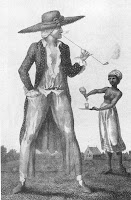 |
| Some sangaree for you Sar? |
These characterizations of the settlers and inhabitants of Colonial Jamaica are nothing new and show a Jamaica that had not come far since the arrival of the English in 1655.
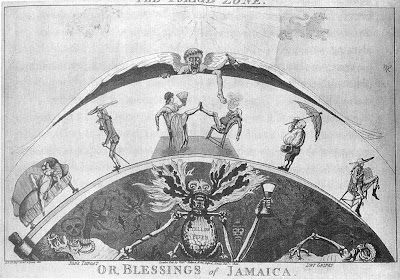 |
| The Torrid Zone, Or Blessings of Jamaica depicts the plantocracy resting in Death's scythe between images of death. nb the unladylike poses...whose illustrious ancestors are these??? |
Jamaica, he wrote, was ‘Sweating Chaos’. The climate was deadly: ‘As sickly as a Hospital, as Dangerous as the Plague.’ Nature itself was also ill, producing wild disorders such as hurricanes and earthquakes. The food was bizarre and disgusting: the planters’ favourite, the spicy Africa-originated pepperpot, was like consuming brandy mixed with gunpowder, ‘an excellent breakfast for a Salamander’; the local “Cussue”* apple was ‘so great an Acid…that by the Eating of one, it drew up my mouth like a hens Fundament’. The pork was ‘luscious’, but, Ward warned, caused scurvy and leprosy. [6]
Most disgusting of all, though, were the people. The men looked as if ‘they had just knock’d off their Fetters’. The women, with nicknames such as ‘Salt Beef Peg’ and ‘Buttock-de-Clink Jenny’, were ‘such who have been Scandalous in England to the utmost degree, either Transported by the State, or led by their Vicious Inclinations; where they may be Wicked without Shame and Whore one without Punishment.’ … [6]
and
“Jamaica, he wrote, had been somehow’ ‘neglected by the Omnipotence when he form’d the World in its admirable Order’. Proper rank and degree, the bedrock of English society, appeared to be absent. Instead, arrivals of whatever hue could be transformed by the island: ‘A Broken Apothecary will make there a Topping Physician; a Barbers Prentice, a good Surgeon; A Ballifs Follower, a passable Lawyer; and an English Knave, a very Honest Fellow.’” [6]
*I assume he means the cashew fruit, which if not eaten when well ripened will indeed draw up one’s mouth like a hen’s arse.Ward describes a colony peopled with the what lef of British society. The not-first-born sons who didn’t stand to inherit and were ill suited for the clergy or scholarly pursuit, women of dubious character, failed professionals, criminals and vagabonds.
We are also told by Ms Rousseau of 1805 Jamaica (and by extension the Colonial era) being a “special place” in time. Nothing could be further from the truth. 1805 was a turbulent time. War was brewing between North America and Britain. France, Spain, Portugal and Britain were fighting the Penninsular Wars; a segue from the French Revolutionary wars. Spain was courting rebellion from New Spain (Mexico). The winds of abolition began blowing in 1787 with the formation of the Society for Effecting the Abolition of the Slave Trade. Slavery was quickly being viewed as a national disgrace. America too felt these winds of change. In 1787 Rhode Island prohibited its citizens from engaging in the trade. In 1791 the first of several bills was introduced in British Parliament for the end of the slave trade. In 1804 the region’s most successful revolt occurred on the island of Saint-Domingue and gave birth to the first black republic, Haiti. Lady Nugent (then just Mrs Nugent), who arrived in Jamaica in 1801 during the Penninsular Wars was terrified that revolting Haitian slaves’ sentiments would spread to her happy blackies in Jamaica.
 In 1805 Jamaica was under Martial Law and in imminent danger of being attacked by the French. The Slave Trade Act was finally passed in March 1807 and enforced on 1 January 1808. Lady Nugent didn’t arrive in Jamaica to sip sangaree at lavish parties. Her presence in Jamaica is a result of her husband, GENERAL George Nugent being sent to the colony as Lieutenant-Governor and part of Britian’s military regiment charged with defence of the colony and suppression of slave rebellions.
In 1805 Jamaica was under Martial Law and in imminent danger of being attacked by the French. The Slave Trade Act was finally passed in March 1807 and enforced on 1 January 1808. Lady Nugent didn’t arrive in Jamaica to sip sangaree at lavish parties. Her presence in Jamaica is a result of her husband, GENERAL George Nugent being sent to the colony as Lieutenant-Governor and part of Britian’s military regiment charged with defence of the colony and suppression of slave rebellions.
These wars impacted the way of life in the Colonial Caribbean. Eastern Caribbean colonies were being traded quickly and cavalierly like cards in a game of pass round donkey. (St Lucia, for eg, changed hands between the French and the English seven times as result of these wars).
We have debunked the fable of slavery being sweet and harmless, the mythos of European and British plantocracy being fine upstanding paragons of virtue and the false notion of the 18thC Fin de siècle being a “special time”. Yet the skewed, gross, misplaced nostalgia for the Colonial Era remains extant. Why? What drives Ms Rousseau and many others to bubble over with it? What fosters the misplaced pride felt by the descendants who post numerous websites peppered with half-truths regarding the lives and times of their ancestor plantation proprietors (landed and absentee)? They create Facebook pages extolling the workmanship of some bent up teaspoon etched with a family crest, or some bric-à-brac china encircled with scenes from their forefathers’ plantations.
Why?
Why?
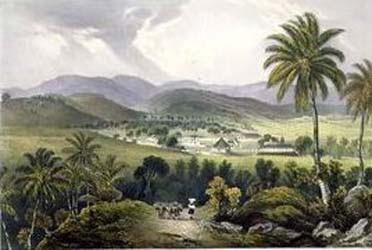 |
| Retirement Estate, St James J B Kidd |
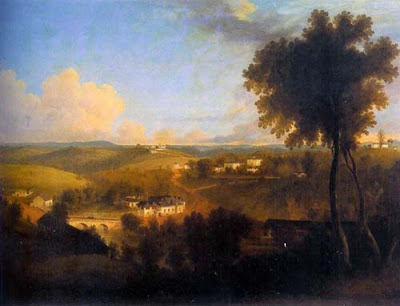 |
| Good Hope, c 1826 J B Kidd |
 |
| The sublime 'Wanderer Above the Sea of Fog,' 1818 Caspar David Friedrich |
Sublime - in nature is an aesthetic quality referring to awesome (and even horrific; grotesque), incalculable greatness; portrayed as a natural landscape feature or architectural feature (folly).
Picturesque - an aesthetic ideal of beauty characterised by a preoccupation with the pictorial values of architecture and landscape in combination with each other.
Beauty - derived from instinct and sensibility vs derived at through reason and calculations (as in the Age of Enlightenment); serene, calm, arcadian.
The picturesque, therefore, existed on the spectrum between the sublime and beauty. Beautiful West Indian vistas immortalized by the 19c oils, line-etchings and aquatints of artists such as George Robertson, Joseph Bartholemew Kidd and architect/artist James Hakewill are powerful in their renderings of nature, but portray a sanitised version of reality that belie and neutralise the horrors of slavery and the realities of plantation life that existed within the natural environment.
Scotsman J B Kidd, master of the picturesque, and his architect/artist counterpart James Hakewill painted similar subjects in the same style. Though a huge admirer of their brilliant, breathtaking work, I acknowledge that these works and similar others created by artists of the time are responsible for many utopic images we have of Jamaica that are misleading.
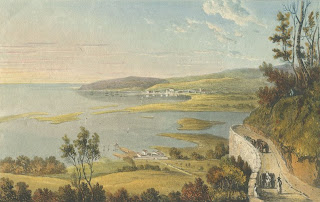 |
| Aquatint of Montego Bay c 1821 J Hakewill |
 |
| Cocoa Nut Walk on the Coast near Ruanway Bay J B Kidd |
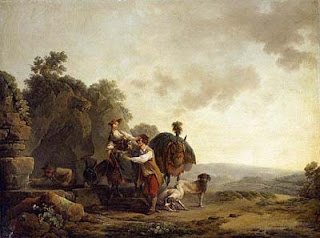 |
| Travellers at a Well, 1769 Phillipe-Jacques de Loutheburg |
The Romantic use of nature suggests innocence. Tamed nature is what we are seeing. Even the slaves in it are tamed. Revolts are painted civilised and orderly.
 |
| Line-Engraving of Roaring River Estate, 1778 (orig painting by George Robertson) |
 |
| The Attack of the Rebels on Monpelier Old Works Estate in the pasrish of St James's Adolphe Duperly 1832 nb the round sugar mill (encircled) similar to that at Bellefield |
Jamaica's beauty was used against her to dispel the unpleasant truth of life in the colony. Who couldn't be entranced and enamoured of the place and lives depicted in these paintings?
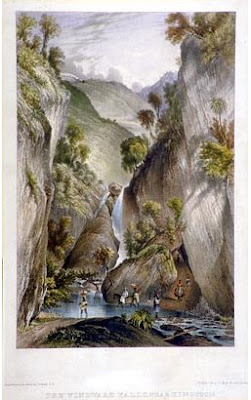 |
| Winward Fall, near Kingston J B Kidd |
 |
| The Date Tree J B Kidd (again, nb sugar mill to the right) |
 |
| The Fern J B Kidd |
From Planter William Beckford Esqr’s Descriptive Account of the Island of Jamaica, 1790:
The cascades, the torrents, the rivers, and the hills, are enchantingly picturesque in their different features, and exchange sublimity and repose of their scenes, according to the variations of the seasons, or the turmoils of the elements.
The docks and weeds of which the foregrounds in Jamaica are composed, are the most rich and beautiful productions of the kind I have ever seen; and the banks of the rivers are fringed with every growth that a painter would wish to introduce into this agreeable part of landscape; and those borders which Claude Lorrain, Poussin, and Salvator Rosa took apparently so much pleasure and pains to enrich, and are excelled by the hand of Nature alone. [7]
nb Beckford's use of the words "Picturesque", "sublimity" and "beautiful".I agree with the man! He’s saying one needed very little artifice to improve upon Jamaica’s brand of Nature. I think Jamaica exceedingly, hauntingly, mystically, timelessly beautiful. But I’m not blind to the evil and the profane and the injustice that occurs there at the hand of its inhabitants.
Idealized appearances appealed to the spectator-owner. This is how they, the plantocracy, chose to see themselves and the relationship they had with their human chattel. Not as the indurate brutes that they were. These picturesque scenes belie the horrors of slavery, the displacement of the Middle Passage and the realities of plantation life.
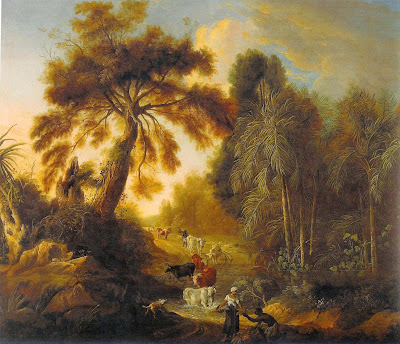 |
| Spring Head of Roaring River, 1775 George Robertson |
excepting the race and legal status of the people.
How many observers of this painting and others similar would question the race and legal status of the human subjects? How many observers would pick up on the fact that these humans are afforded non-status in plantation society? How many observers did it occur to that the humans - slaves - are as much chattel as the livestock being driven behind them?
The above section regarding art and its interpretation merely skims the surface. A more thorough analysis was forfeited for expediency's sake. But one can see how such scenes, create(d) cognitive dissonance in many of their observers: There’s nothing brutal and inhumane going on here?! What are these abolitionists playing at? Why get rid of this life? What’s wrong with it? They seem happy to me?!?
This dissonance was/is so powerful; so potent, it spanned the geographic distance between Jamaica and Britain, and spans the temporal distance between slavery days and the 21st century, so that 200 years later we get:
“It really is a step back in time, you know, in the heyday of our sugar production. So, you know, that’s kind of what we try to do here: take people back in time, you know, to 1805 before the abolition of slavery when Jamaica was a really special place….”
Where, pray tell, are the 7-minute promotional soundbites and the Facebook pages that proudly display the ancestral portraits, soup toureens, mercury phials, penis syringes, bidets and other tchotchkes of the rag-tag descendants of Thom Thistlewood, 'Salt Beef Peg' and 'Buttock-de-Clink Jenny'?
-Torsdag
Bibliography
Barringer, Tim, Gillian Forrester, and Barbaro Martinez-Ruiz. Art and Emancipation in Jamaica: Isaac Mendes Belisario and His Worlds. New Haven and London: Yale Centre for British Art in association with Yale University Press, 2009. [3] [4] [7]
Hall, Douglas. In Miserable Slavery: Thomas Thistlewood in Jamaica 1750 - 1786. Barbados, Jamaica, Trinidad & Tobago: University of the West Indies Press, 1989. [2]
Parker, Matthew. The Sugar Barons: Family,Corruption, Empire and War in the West Indies. New York: Walker & Co, 2011. [1] [3] [6]
Wright, Philip. Lady Nugent's Journal: of Her Residence in Jamaica from 1801 to 1805. Barbados, Jamaica, Trinidad & Tobago: University of the West Indies Press, 2002. [5]



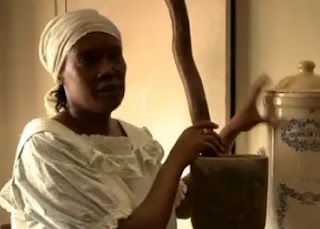



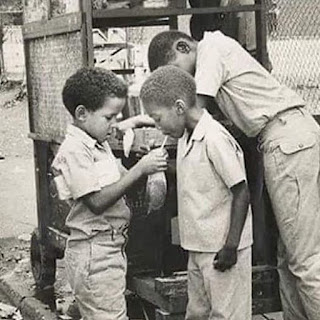
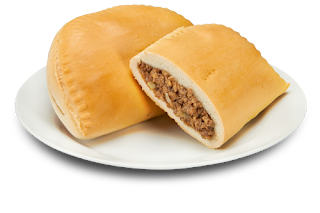
Thank you for your wonderful insights into an important but often glossed over aspect of Jamaica's history.
ReplyDeleteThe ahistorical and overly "colourblind" portrayal of Jamaican slave society is absolutely disgusting! I understand Ms Rousseau is trying to "Sell" a product, but grossly distorting a nation's history for profit is unethical to say the least.
Keep on educating the masses!
Thank you
ReplyDeleteThank you, I haven't read it all, but what I did, I find very informative. I have shared your site with several people today & I believe that you are speaking the truth. I am an American and have been living in Jamaica for 10 years now. Once upon a time I deliriously thought I knew most things about Jamaica, come to find out I know very, very little. It takes some digging to get to the truth, when a society is trying it's best to survive on tourism, thus presenting a 'pretty face' at all times. I thank you again.
ReplyDeleteExcellent! Can you tell me where the quote from James Stewart comes from?
ReplyDeleteThanks!
I asked tour guides what the cross on the hill was , One said she didn’t know it existed , the other said it must be someone making a statement then they started talking in their slang tongue , so I don’t know why neither talked about Francis Kerr-Jarrett
ReplyDelete